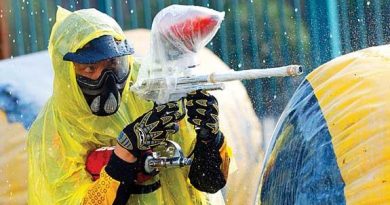Has paintball technology reached a plateau?
When is the last time you heard of a new sweet soccer shoe? Or an awesome new football? Or a revolutionary pair of ice skates? Have you ever heard of new technologically advanced golf clubs? Sure, Callaway’s ERC was new and slightly revolutionary, but not too different than standards golf clubs.
In most other sports, the technology has reached a general plateau and is no longer developing real new advances. Sure the marketing of the latest soccer shoe may try to make it sound like it is years ahead of its competition, but in the end it’s still your basic soccer shoe.
How about paintball? Have we reached a technology plateau? As our industry grows and matures, we will eventually reach a plateau. But are we there yet? That’s a good question.
How long has it been since we’ve seen a real change in the technology of the basic paintball? In the early 90s, paintball were made very similarly by just a few companies. They were two halves that were sealed together, making a slightly flattened, not very round paintball.
In the mid to late 90s, Marballizer paintballs were introduced, then All Star paintballs and so on and so forth. Eventually, we ended up with the new non-glossy paintballs that were made of “plant fibers”. But for all intents and purposes, the paintball can not become more advanced than it already is now. There hasn’t been any real advancement in over 3 years.
How about paintball masks? Have they changed? Ever since Spectra introduced the fan and vents back in the mid 90s, no masks have pretty much remained the same.
Shoes, pants, jerseys, shirts? Yes, these are not necessary to play paintball, but companies have been introducing lots of new “accessories”.
So how about the markers? 1985 through about 1989 paintball markers were basically pump guns that were used to mark cattle with oil based permanent paint. The markers used 12oz CO2 cartridges. In the early 1990s, larger CO2 tanks became popular, but were extremely expensive. Eventually, those tanks became the norm.
In the early 1990s, Glen Palmer figured out how to redirect part of the pressure coming from these larger CO2 tanks to help re-pump the gun automatically. Palmer started using these on all of his brand of markers like the Typhoon. Eventually, Bud Orr and Palmer figured out a way to make the popular pump gun, the Sniper, also recock using nifty pneumatics. That’s when the Autococker was born. It became an instant hit.
Tippmann quickly figured out how to make markers that would recock using part of the air that was used to fire the paintball, without all the fancy pneumatics that Palmer used. They argued that the Palmer pneumatics were to “fragile” and exposed to possible damage. These Tippmann “blowback” systems became the industry standard and just about every field in America had Tippmanns as rentals. If your field didn’t have Tippmanns, then you should find another field.
A few years later around 1994-1995 the first few compressed air systems joined the market. These provided paintball players extra consistency and performance in colder climates. Of course, this caused a huge decrease in the cost of regular CO2 tanks, which was great.
Some years later, in the mid-90s, Smart Parts came out with the Shocker, the first electronic marker. While it was quite an advancement, it wasn’t as reliable. Detractors always argued, “What do you do if the batteries run out in the middle of a game?” But Smart Parts kept on chugging improving their markers. Of course, they eventually added the Impulse around 1998.
Also in the mid to late 90s, a little known company from England, WDP, came out with their first ever electronic marker, the Angel. No one thought that these would catch on, but for some reason they did. WDP understood the importance of slick marketing, and were able to sell tons of their markers. Unlike the Shocker, they used an internal large battery that could fire “40-60,000 rounds” before needing a charge.
In the mid 90s, we also saw the invention of the electronic hoppers. These ball-feeding machines could feed an entire hopper in about 20 seconds. That’s about 8 balls per second. Of course, electronic hoppers would go through their own evolution. Today’s hoppers can feed an entire hopper in less than 10 seconds.
At the turn of the century, in the early 2000s, companies invented the “swing” style triggers for Autocockers. Although, most don’t view this as significant, this allowed Autococker owners to have the same style trigger pull as Spyders, Angels, and other quick release triggers. While not as light or short as electronic, it was pretty close. These gave Autococker owners renewed hope that their markers were not antiquated and could still compete.
Later in 2000, the Intimidator was born. Bob Long, backed by National Paintball Supply, launched his newly developed marker. It was electronic, non-blowback, low-pressure, and highly customizable. It was supposed combine all the benefits, accuracy, low-pressure of the Autococker with the speed and agility of the Angel. A marvelous product was born. Of course, it did need some fine tuning and work, but eventually became an amazing product.
By 2002, we had the avalanche of electronic grip/trigger upgrades for everything. Almost every marker that was not electronic, could now be upgraded to electronic. At first, some of these kits cost an arm and a leg. They were not mass produced and were very expensive. But with Planet Eclipse and others mass producing electronic trigger upgrades, almost every marker today has become an electronically fired marker.
What was interesting about these upgrades is that they didn’t necessarily convert the entire marker to electronic, they just made the activating mechanism electronic. For example, an Autococker still uses air to fire and recock, but the electronics in the grip now trip the circuit. It was very air efficient and battery efficient. Batteries can last a long time when they aren’t doing much.
The past two years, since 2002, we have seen minor improvements and adjustments in paintball technology., but nothing really revolutionary has come down the pipe. Are we finally saturated? What else can we improve? Has paintball technology finally reached a plateau?
Of course, when you are experiencing a plateau, you never really know you are in one until you’ve been there for a few years. So are we at the end of the line for major technological advances? It’s hard to tell if you are going to see another major improvement. But of course, the possibility remains.
What type of improvements can we expect? Will we ever see markers that do the aiming for you? Like a heat-seeking type of device? Will we see hoppers that are half the size, but hold twice as much? Will we see better paint? Will there be paintballs that are small and shrunken and grow as they fly through the air?
There isn’t much more to improve, but you never know.




